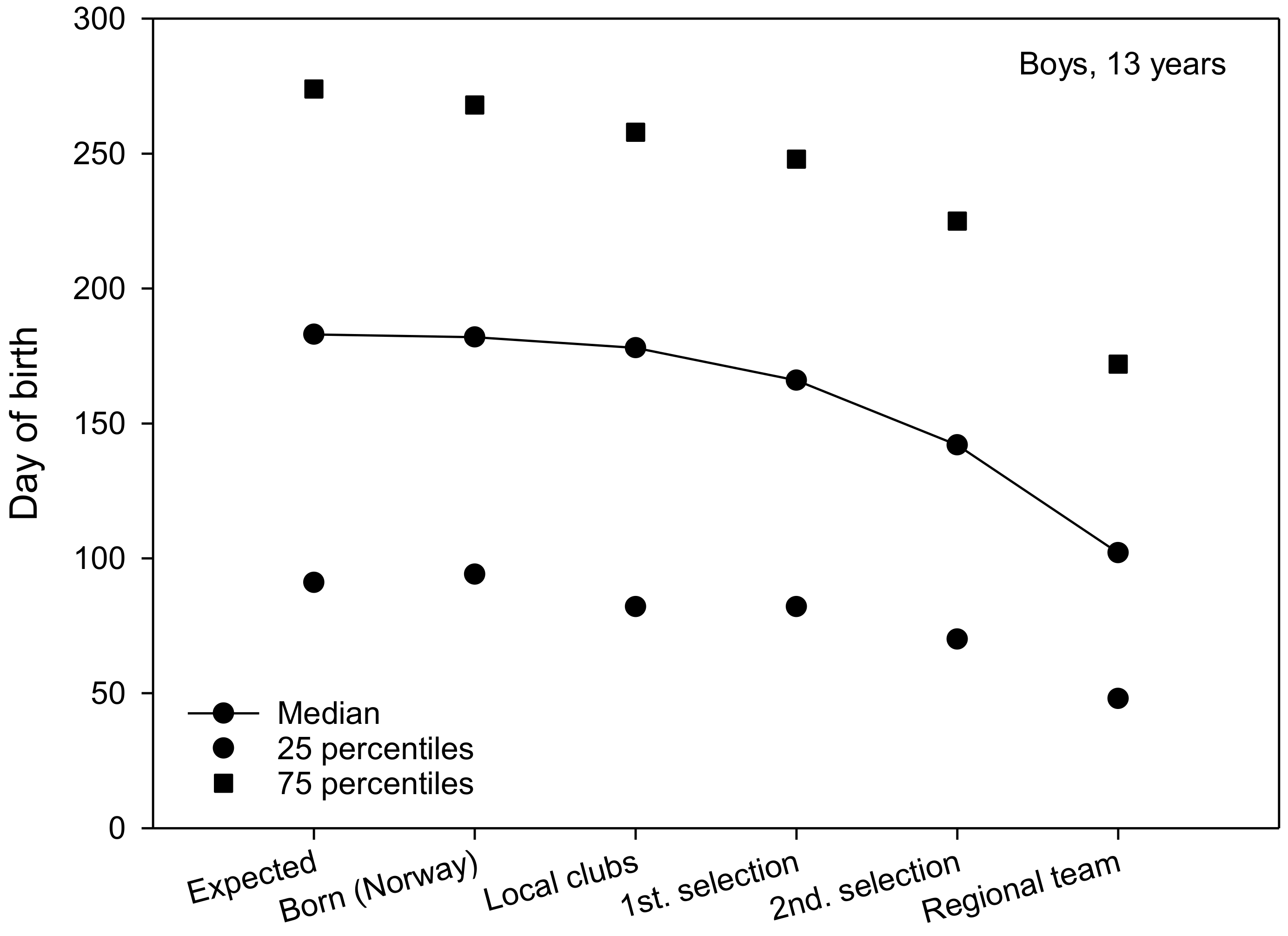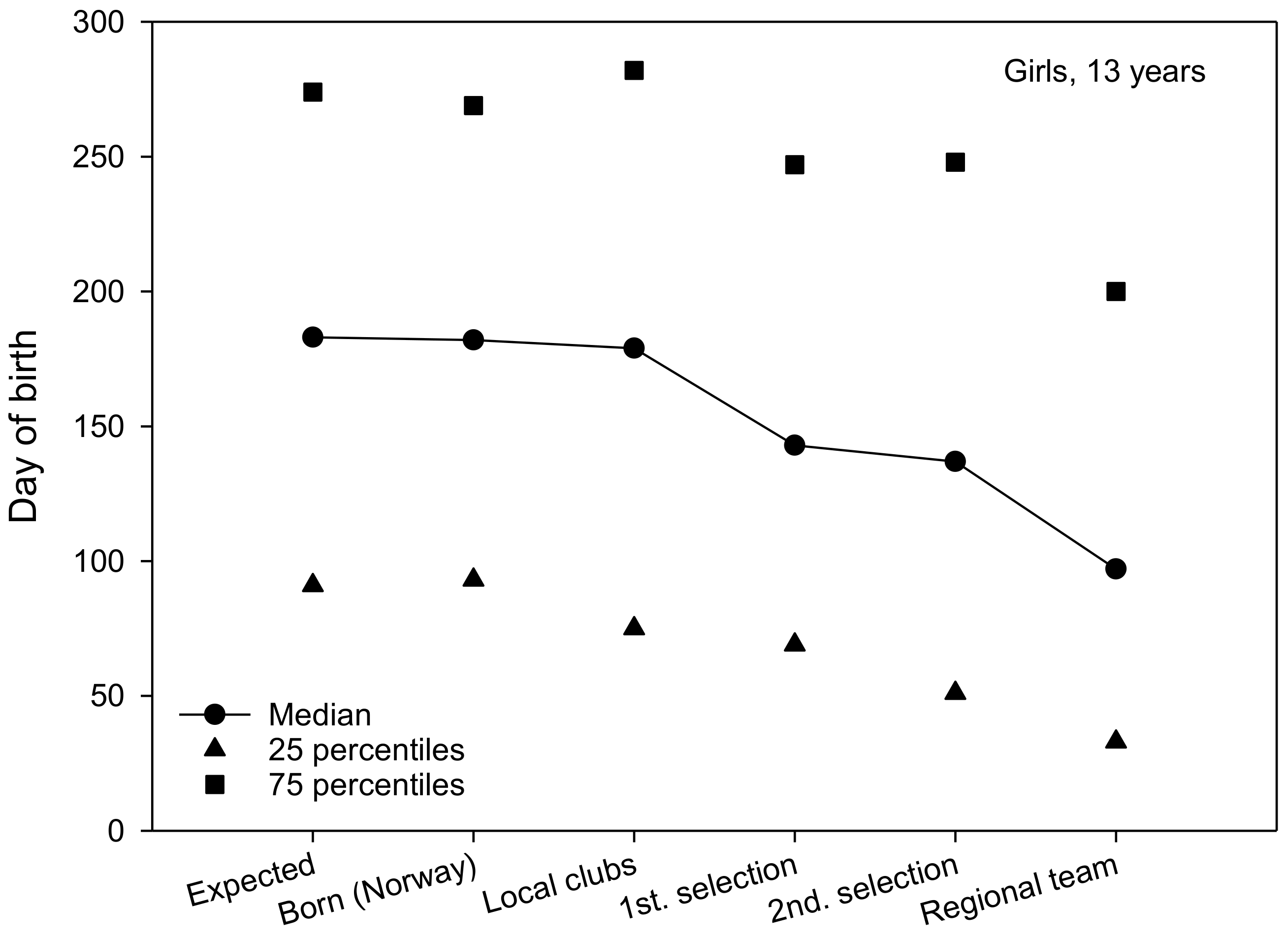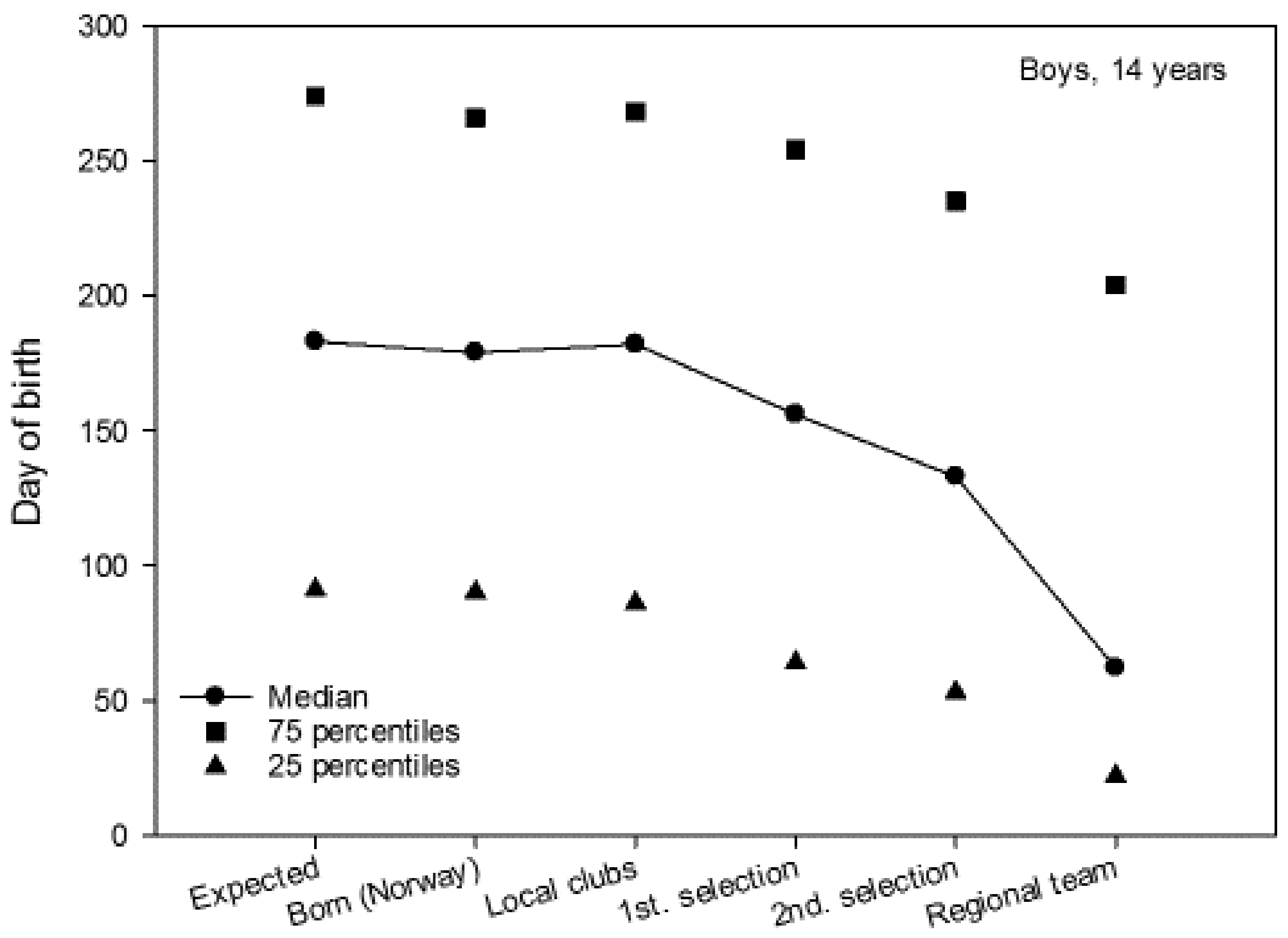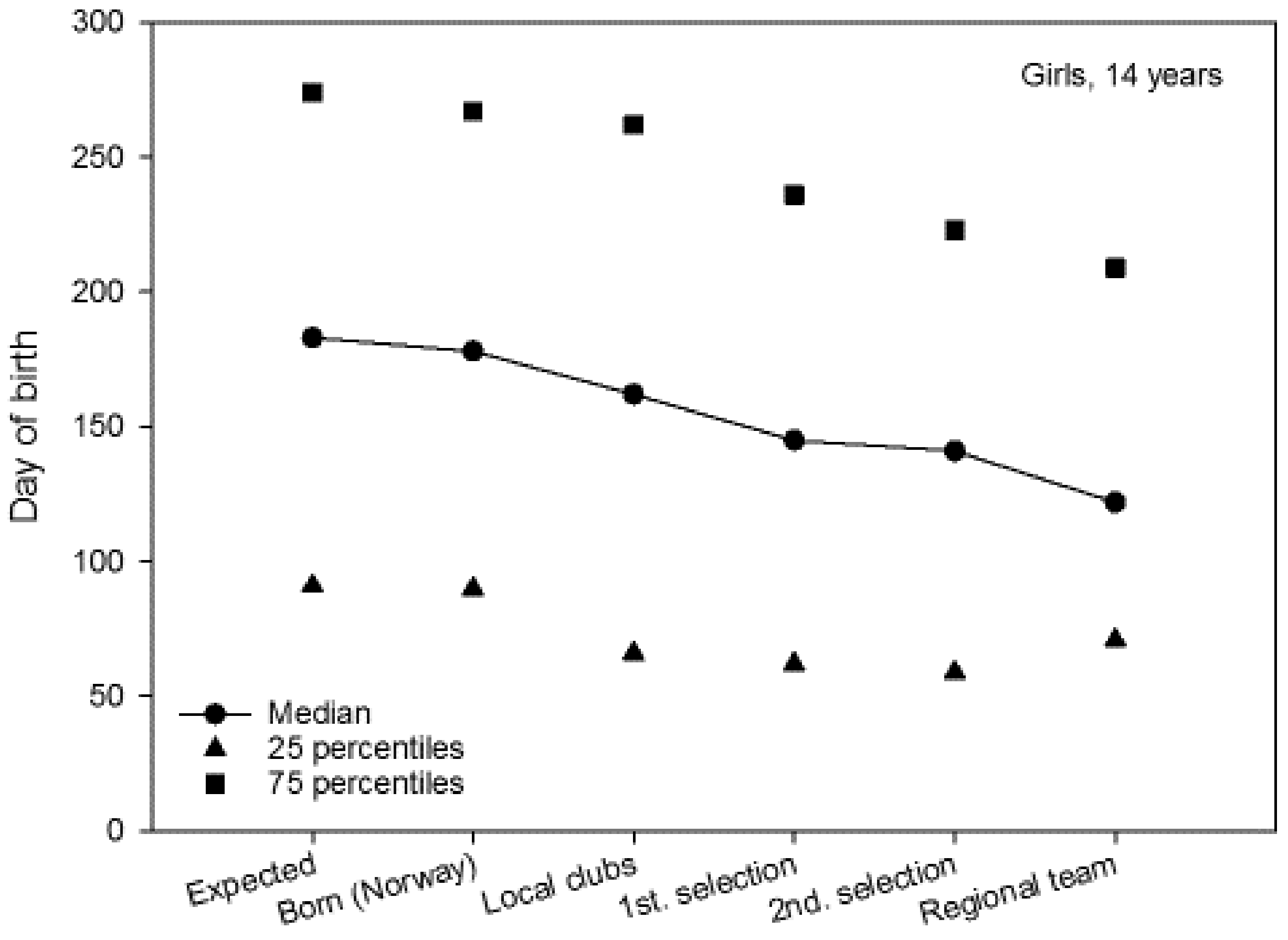1. Introduction
In Norway, as in many other countries, children and adolescents in sports are grouped based on year of birth. By definition, a range of one year will exist between people who compete in the same age group in sports, such as soccer. The difference in age within the same age group is termed the relative age difference (RAE) [
1,
2]. Within the same age group, this factor will contribute to individual differences in the rate of development and maturation of physical, technical and mental abilities, in addition with genetic factors, experience, gender, etc. Therefore, the RAE can contribute to advantages and disadvantages for individual achievement in sports [
3,
4]. The RAE is at its maximum when a child born in late December is compared with another child born in early January of the same year (with January the first as cut off). However, as the children grow, studies have reported that the RAE, as such, will disappear along with growth spurts and the maturation process [
1,
2].
In most sports, those reaching puberty early have an advantage over their later-developing peers, because biological-maturity status constitutes a major factor for performance capacity [
5]. In sports in which height, weight, strength and power constitute an advantage, the early-maturing boy or girl at any given age is likely to possess a biological advantage over those who mature later [
5]. Therefore, physical maturity in sports gives girls and boys an advantage that might well be mistaken for superior ability. When strict selection procedures and/or criteria are applied to such groups, which is commonly found within sports, RAE should be expected [
2]. The individual’s maturation, together with the selection procedures in sports, are suggested to influence the individual’s ability to invest time into practice and to accumulate sport-specific skills and experience, factors that are critical for long-term performance [
6].
Theoretical support for the RAE can be found in the concept of developmental-advantage socialisation and the Pygmalion effect [
7,
8]. Children born early in the year are more often defined as ‘talents’, and are selected for talent camps or teams. The selected children are provided with the best coaches and facilities, and are thus given superior opportunities for development. The initial selection appears, as such, justified because these children develop more quickly than those not selected [
9]. Therefore, RAE in sports seems to be enhanced by the so-called Pygmalion effect, in which an individual will perform better when more is expected of him or her (see Rosenthal, 1968). Moreover, Harter’s (1978) competence motivation theory suggests that athletes who perceive that they are able to perform at a high level and are talented, are more likely to continue perfecting their abilities and to invest more time and effort into their sport, with predictable results [
8]. Consequently, it may be reasonable to assert that selection for regional teams may affect how adolescents evaluate their talent in soccer.
The selection procedure for a regional team at B13, G13, B14, and G14 in the middle of Norway comprises three stages. In stage one, the club coaches select the top 2–6 players in the club (approximately 15% of all players) to take part in three training sessions and two matches. Approximately 30–40% of these players are selected, mainly by the club coaches, to participate in stage two, which includes playing two matches. Finally, a regional team coach selects 15% of these players to play for the regional team at stage three. At every stage, everyone involved in the selection process has to select a maximum of 60% of the players born in the first six months of the year, while at least 40% have to be born in the last six months of the year. This is in accordance with the selection document formulated by the Troendelag Regional Football Association (Troendelag fotballkrets, 2016) —a strategy for decreasing RAE in the selection process.
The selection procedures formulated by the Troendelag Regional Football Association are an important strategy in an attempt to prevent RAE in soccer, which has been identified in an extensive body of literature [
10,
11,
12,
13,
14,
15,
16,
17,
18]. However, despite the strategies that have been implemented to avoid RAE in the selection process, it remains unknown if the coaches succeed in avoiding RAE. Studies demonstrate that the RAE decreases with increasing age [
12,
15,
16,
19]. However, as in other RAE research [
4], most of these studies do not include girls. In fact, only Delorme et al. (2010) and Liu and Liu (2008) include girls, and they documented RAE among French and Chinese girl players, respectively [
10,
14]. Furthermore, these investigations do not include adolescents younger than 15 years of age, and they do not examine RAE throughout the different stages of the selection process. In general, they focus on RAE in settings of national teams or elite players.
Knowledge of RAE among young players of both genders, and how it occurs in different stages of the selection process, is critical for coaches that are responsible for selecting players, as well as for researchers, teachers, players, parents, and employers in regional and national soccer associations. However, there is a lack of knowledge in this research area. Therefore, the objective of this study was to elucidate what is the RAE in three selection stages of the regional team (B13, G13, B14, and G14), and when a selection criterion exists of 60/40% born in the first/last six months of the year. We also aimed to identify any gender differences in RAE.
3. Results
The expected date of birth was a constant set at 183 day of birth for all teams. The median for 13-year-old boys and girls was 182 (
Figure 1 and
Figure 2). The median for local club teams in the Troendelag Regional Football Association was 178 and 179 for 13-year-old boys and girls, respectively. Further in the selection process, the median of the first regional selection was 166 and 143, the second regional selection 142 and 137 and the regional teams 102 and 97, for 13-year-old boys and girls, respectively. For 13-year-old boys, 25% of the regional team were born before 18 February, while 75% of the regional team were born before 22 June (
Figure 1). For 13-year-old girls, 25% of the regional team were born prior to 3 February, while 75% of the team were born prior to 20 July (
Figure 2). The average regional team player was born approximately two and a half months (76 days) for 13-year-old boys (76 days), and almost three months (82 days) for 13-year-old girls before what might be expected according to the birth data for soccer players in the Troendelag Regional Football Association (
Figure 1 and
Figure 2). Further analyses revealed that 77.8% of the boys and 72.2% of the girls on the regional team were born in the first six months of the year. Significantly more players were born in the first six months, versus those born in the last six months at the second selection (χ
21 = 7.2, p = 0.007), and at the regional teams (χ
21 = 5.3, p = 0.021).
The median for 14-year-old boys and girls was 179 and 178, respectively (
Figure 3 and
Figure 4). The median for local club teams in the Troendelag Regional Football Association was 182 and 162, for 14-year-old boys and girls, respectively. Further in the selection process, the median of the first regional selection was 156 and 145, the second regional selection 133 and 141, and the regional teams 62 and 122, for 14-year-old boys and girls, respectively. For 14-year-old boys, 25% of the regional team were born before 23 January, while 75% of the regional team were born before 24 July (
Figure 3). For 14-year-old girls 25% of the regional team were born prior to 13 March, while 75% of the team were born prior to 29 July (
Figure 4). The average regional team player was born approximately four months (120 days) for 14-year-old boys, and one and a half months (40 days) for 14-year-old girls before what might be expected according to the birth data for soccer players in the Troendelag Regional Football Association (
Figure 3 and
Figure 4). Further analyses showed that 72.2% of the 14-year-old boys and 66.7% of the 14-year-old girls on the regional team were born in the first six months of the year. Significantly more players were born in the first six months, versus those born in the last six months at the second selection (χ
21 = 4.5, p = 0.007), but not at the regional teams (χ
21 = 1.6, p = 0.215).
Further statistical analyses (Mann–Whitney U-test) revealed that there were no significant gender differences in terms of RAE for club teams (Z = −0.965, p = 0.335), first regional selection (Z = −1.314, p = 0.189), second regional selection (Z = −0.011, p = 0.992), or regional team (Z = −1.014, p = 0.311). Moreover, no significant differences were found in the date of birth between players in the year cohorts 2002 and 2003 in terms of club teams (Z = −0.671, p = 0.502), first regional selection (Z = −1.224, p = 0.221), second regional selection (Z = −0.898, p = 0.369), or regional team (Z= −0.417, p = 0.677). The IQR in three of the four figures shows that the variation in date of birth diminishes the further the players advance in the selection process. Here, G14 stands out by having approximately the same dispersion measure for all six groups. The 25th percentile is also substantially lower for the G14 players.
4. Discussion
The main finding of the present study was that, despite the intention to reduce RAE in the selection process, i.e., through setting the criterion that at least 40% of the players should be born in the second half of the year, boys and girls born in the first half of the year are more likely to be selected. In addition, club coaches seem to consider the criterion of distribution (60/40 first/second half of the year) for players in the first selection stage. However, as the competition becomes more intense during the selection process, the distribution criterion becomes increasingly disregarded, and the RAE is highest at the last selection stage conducted by the regional team coaches. At this final stage of the selection process, the RAE among the players is in line with other studies that have investigated RAE in cases in which the distribution criterion is not used for the selection process, i.e., 70–75% born in the first half of the year [
2,
20]. This is also supported by our finding that the teams for both boys and girls had a higher mean age at each stage throughout the selection process. Musch and Grondin (2001) highlight that competition to obtain a place on the team constitutes one of the primary mechanisms for RAE. That there are representatives from the organisation that set the criteria for distributing players born at different times of the year, and who ultimately select the oldest players, reveals how pervasive RAE is regarding competition between boys and girls in one developmental age group. Indeed, RAE is commonly associated with several major advantages in sports, such as physical capabilities, experience, and psychological factors.
Children born early in the year often possess the advantage of being taller, stronger, and faster [
21]. The results from this study identifying the relationship between date of birth and selection to the regional teams are in accordance with studies in sports, indicating that when advanced physical development is advantageous, the youngest age group is at a relative disadvantage [
5]. Moreover, in sports, advanced physical development might be mistaken for superior ability in favour of those who mature early, and therefore are more readily positively evaluated in the selection process. Jimenez and Pain (2008) also argue that such criteria for the selection of young players lead to less development among players who are not selected [
22].
Another issue that is highlighted by our results is the element of experience. It is suggested that the quantity and quality of practice constitute primary mechanisms in explaining skill or performance attainment [
6]. An 11-month difference in age represents almost one year of additional opportunities to practice, which can translate into substantially more training for the oldest pupils. Perhaps a more common factor is that more mature children have been found to have a higher likelihood of being chosen to be part of a team with higher abilities [
4]. This will typically provide the more mature adolescents with better coaching, more opportunities to face highly skilled opponents, additional training, and training at a generally higher competition level. Furthermore, more mature children will typically receive the opportunity to have more active participation in the games.
In Norway, as in many other countries, children and adolescents in both school and sports are grouped based on year of birth. The difference in age within the same age group is called the relative age difference (RAE) [
1,
2]. Within the same age group, the range of one year between people who compete in the same age group will contribute to individual differences in development and maturation rate. Therefore, the RAE can contribute to advantages and disadvantages for individual achievement in sports and at school [
3,
4]. Both RAE and biological age should be taken in account for selection. Even if the findings show an increased RAE in the selection process, it is appropriate to note that the results find no RAE among the soccer players who play soccer in Troendelag county, which can be considered to constitute an overall positive situation.
Another main finding is that no significant gender differences in terms of RAE exist in any of the selection stages. Although several studies have identified RAE in soccer [
10,
12,
13,
14,
16,
17,
18,
19], most of these studies do not include girls. In fact, only two studies included girls [
10,
14], and the present findings of RAE among girls support these studies. However, the playing rules in soccer are the same for both boys and girls in terms of physical contact, including tackling, and according to the previous discussion, this equivalence seems to play an important part in creating an RAE. This may explain why the RAE is higher among men than women in ice-hockey [
23], where the women’s regulations do not allow as much physical involvement compared to the men’s regulations.
As argued in the introduction, theoretical support for the RAE is given by developmental-advantage socialisation and the Pygmalion effect [
10,
11]. Adolescents born early in the year will more often be defined as talents, and be selected to regional teams. Here, they are provided with the best coaches and superior training facilities. With such a strategy, they receive better opportunities for development, and the expectation is fulfilled and justified in relation to the Pygmalion effect [
10]. Moreover, athletes who receive such attention from coaches, perceive that they are talented and have a better chance to continue developing their abilities and investing more time in soccer [
11].
The present study possesses two major limitations. First, although the overall sample includes 3022 children, the RAE in the four regional teams is analysed with data of only 72 children. In order to increase the robustness of the findings, future work could include a larger sub-sample. Second, only two age groups were examined in the study. Even though these two age groups are considered to be times during which growth spurts are at the highest, future research could incorporate additional age groups to increase the study’s generalizability.









